Pop-ups are quickly becoming a popular M.O. for enthusiasts in all facets of life. We often hear of people taking a parking spot and transforming it into a disco club for a lunch hour, or experimental restaurants using found food to create delicious meals in strange locations. Temporary by design, pop-ups allow creative people to try out an idea without large start up fees or capital costs.
Pop-up museums are gaining popularity as museums strive to find new places to connect with more people. According to Santa Cruz Museum of Art and History, a pop-up museum “is a temporary exhibit created by the people who show up to participate. A pop up museum usually lasts for a few hours on one day and focuses on bringing people together in conversation through stories, art or objects.”
The Edmonton City as Museum Project has been experimenting with pop up museums for well over a year, cutting our teeth at the Collingwood Farmers Market, Free Admission Day at the Prince of Wales Armouries, CKUA’s Party in the Park, and the Servus Heritage Festival. Now that we have a number of pop-ups in the books from a variety of locations, we thought we’d share five interesting insights we’ve gleaned from our experiments thus far.
Pop-ups Appeal to Streakers…
No, we haven’t had a naked person run through our pop up. Traditional museum visitors display three different types of engagement, which can be termed the streaker, the stroller and the studier. Basically, streakers will look the exhibit over and look for the higher-level impact of the story told. Strollers will walk from area to area and, based on the content, engage with sections or stories that appeal to them. The studier will take as much time as they want and really absorb the message of the exhibit. Each of these visitors will need a different hook to interest them and we take this into account when planning a pop-up.
Our pop-ups have seen large numbers of all of these types, so we structure how we ask our questions and how to answer them with a different level of engagement in mind. For the streaker, we offer a quick vote questions of universal appeal that requires a gut response and the drop of a pebble. For strollers, we have open-ended questions that require some personal reflection and then sharing in a sentence or two. It can be tagging a map with a location pin or filling a guestbook with their favourite song. Finally, for the studier we have pre-event opportunities to engage with the exhibit theme, reflect on it and purposefully come down with their own objects and stories to share. At the exhibit we have 3 or 4 questions with at least one that is emotionally provocative and requires a thoughtful paragraphed response (on brightly coloured post-its!).
- A crowd gathers at the pop-up museum held during Heritage Festival.
- Visitors young and old and from all walks of life have something to add to a pop-up museum.
- Visitors young and old and from all walks of life have something to add to a pop-up museum.
Pop ups are conversation starters.
Regardless of whether you’re a streaker, stroller, or studier, we won’t hold back from asking you a question. We genuinely want to know more about each person who visits the exhibit and will often ask “why is that – do tell!” In our experience, people will share even more by talking to us than by simple writing down in our exhibit. It also creates conversations between visitors and stories brought forth are often explained or remembered in tandem with another. This is the engagement we enjoy watching the most – laughter and connecting shared history between Edmontonians is ultimately what ECAMP is about (bonus points if it is strangers making each other smile!).
- Everybody can add their thoughts, opinions and a splash of colour to our conversation boards.
- A friendly message at an ECAMP pop-up
Pop ups are super easy to plan (and totally not easy to plan).
They’re super easy once you have the location and gear (tables, maps, frames, post-its). From there all it takes is some brainstorming around the theme and what techniques or hooks to use to get good responses. This sounds easier than it is, as the quality of answers depends on the quality of your questions. Thankfully, there are websites like storycorps.org that provide inspiration and evocative questions. We toss possible questions back and forth as a team, swapping words to find truly impactful questions related to our theme. Another key to good answers is finding themes that are universal and humanizing (freedom, celebration, diversity) allow anyone from anywhere to find a way to engage the exhibit.
- All you need is some space, some craft supplies, some questions and an open mind.
- All you need is some space, some craft supplies, some questions and an open mind.
Pop ups are temporary.
The value of this is really threefold. First, exhibit improvements, good questions, and layouts can be refined and implemented in the next exhibit. Pairing themes with techniques and questions is part fine art and part chemistry, so the ability to feel what will work and at what time is something that requires a certain degree of trial and error.
Second, it allows for great “first date” partnerships. It gives you the opportunity to show a prospective partner organization what you can do and see how far a relationship could go. It can reveal similar missions, better audiences, or organizational incompetence. Whatever the result, you have another lesson to take forward to your next exhibit.
Finally, it allows for cool, unusual and non-traditional locations to experience heritage. We have held or seen pop ups in farmers markets, radio stations, festivals and even shopping malls. By diversifying where you are, you naturally diversify who you are talking to.
- With boundless archives and creativity, CKUA is one of many organizations in the city that make a great partner.
- And new partnerships can bring you to places you never thought you’d go.
Pop ups are democratic—it’s true public expression.
If they like the pop-up, they’ll stop. If they really like it, they’ll stay and play. If they love you, they’ll bring someone again and again.
Pop-up museums are great for putting arresting content in a unique setting. They can reach people who may not see themselves and their stories represented in other types of museums. Stories shared can be more personal, relevant to our community and hopefully mark our museum project as listening and connected to our citizenry.
- Here, many people gave their thoughts on the topic of ‘freedom’.
- Here, many people gave their thoughts on the topic of ‘freedom’.
- Here, many people gave their thoughts on the topic of ‘freedom’.
- Here, many people gave their thoughts on the topic of ‘freedom’.
These are just five quick reasons we love doing pop ups. We trust that as we continue to pop up through the city we’ll discover more ways to use the idea of temporary exhibits to show and tell our city’s history. We encourage, nay, CHALLENGE museums to try popping up in unexpected spaces and have fun discovering what makes your community pop.
—
Monica Roberts is the EHC’s City Museum Strategy Coordinator, a position that has her constantly meeting people and finding interesting ways to excite, question, and provoke Edmonton’s heritage.
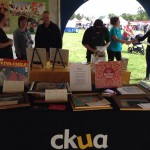
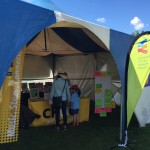
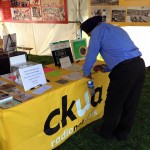
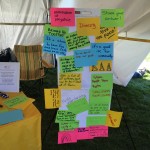
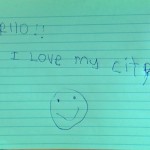
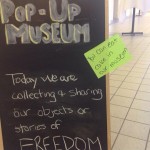
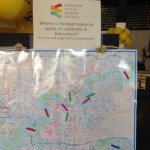
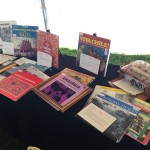

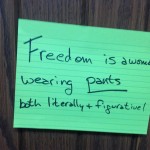
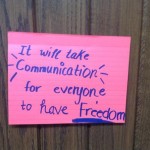
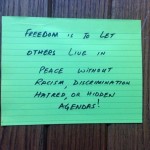

The Mill Woods Living Heritage project is currently developing a pop-up exhibition in a two-step process. The first day we will have a workshop in which participants re-enact the Grey Nuns Rally of April 1994 and then we’ll work with them to create their own display panel about a place of significance to them personally in the area. We’re also creating a number of display panels ourselves. All of these panels will be installed at the same time one weekend this fall. Stay tuned for more information as the project develops. If you’re interested in becoming involved, please contact CatherineC.Cole@telus.net